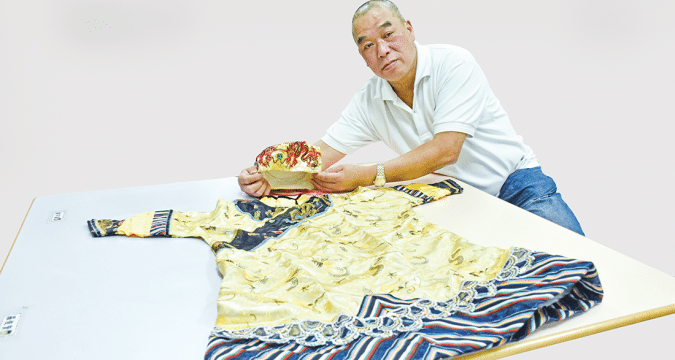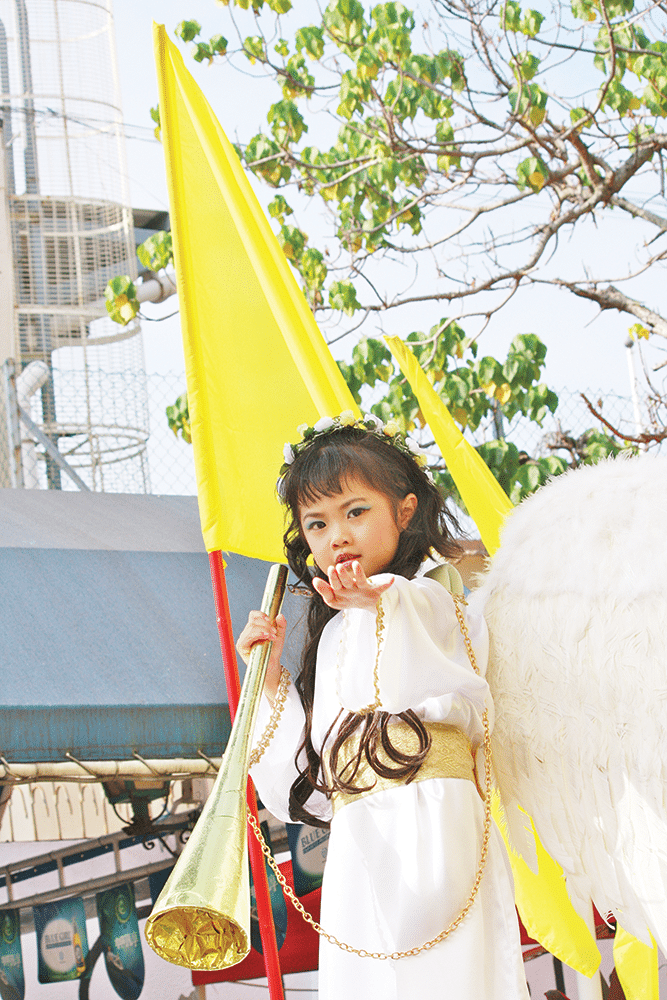
HONG KONG (SE): Young children who seem to float in mid-air [Piu Sik] used to be one of the highlights of the annual Cheung Chau Bun Festival parade. In these floats, children dressed to represent iconic figures from Chinese history, folklore, or news stories of the day, and were secured atop of hidden supports as they were held aloft during the procession.
Our Lady of Fatima parish in Cheung Chau, adapted the use of floats for its annual Marian procession, on the occasion of the feast of Our Lady of Fatima, in 2005
It was the idea of late Maryknoll Father John Ahearn, then the parish priest, to add inculturated regional flavours to the procession. With the floats, children were dressed as angels, imparting showers of blessings on the people of Cheung Chau.

Luke Ng Mun-tong, who was responsible for the production of the first floats, recalled that the preparation were a challenging test of faith. Father Ahearn had entrusted Ng, a mechanical engineer by profession, to handle the production of floats. He recounted that he could deeply feel the support of God and the Blessed Virgin Mary in moments of trials.
In an interview with the Kung Kao Po, Ng recalled that the project was a journey of faith. The first challenge was to convince the masters of floats of the Da Jiu Festival to share the technical know-how. Ng and his team members were repeatedly rejected, as the masters were hesitant to disclose traditional float-making skills to members of the Church. However some technicians were persuaded to help.
The introduction of the Piu Sik to the parade helped the villagers recognise the goodwill of the parish.
According to Ng, compared with the floats in the parish procession, the floats of Da Jiu Festival are far more exquisite and the traditional parade takes hours. Children in costumes featuring characters from Chinese legends and history as well as prominent people in society are the highlights.
In the parish procession on the other hand, children act as the guardian angels for China, Hong Kong and Cheung Chau. The Angel of the Annunciation was added in later processions.
Ng and other volunteers also taught the children to impart blessings by laying hands on the onlookers, instead of waving them. Initially, the children could not understand. “So, we told them it is like a hand gesture used by their teachers telling them to sit down. Then they understood at once,” Ng recounted.
Among all the costumes prepared for the floats, Ng was most pleased with the queen costume for Our Lady of China.
He said that the difficulty of producing a float is in showing a beauty in lightness, which depends on whether the shape of the metal frame can safely support a child and enable easy movement. At the same time, the frame should be covered up so that it cannot be seen.
Under normal circumstances, the annual procession takes place after a rosary prayer and Mass. Before the procession, Sunday school catechists will explain the story of Blessed Virgin Mary to the children.
Starting from the parish, the procession led by a Holy Cross and accompanied by an image of Our Lady of Fatima, passes along Tung Wan Road, Pak She Praya Road before heading back to the parish.
The procession is also joined by Filipinos who appear in colourful gowns, incorporating their tradition of the Santacruzan [Holy Cross] procession—a legacy dating back to the time of Spanish colonisation, commemorating the discovery of the True Cross by Empress Helena, the mother of the Emperor Constantine.
Filipinos observe the tradition known as Flores de Mayo [Flowers of May] throughout the month of May with a daily offering of flowers to the Virgin Mary, culminating with the glittering procession of the Santacruzan on May 31.
His daughter told him that she was not worried at all as she believed the Blessed Virgin Mary would protect her. Looking back, Ng is still amazed at her faith.
Ng remembered that most parishioners did not dare to let their children stand on the floats when they were first introduced. So he had no choice but ask his four-year-old daughter to be one of the angels. His daughter told him that she was not worried at all as she believed the Blessed Virgin Mary would protect her. Looking back, Ng is still amazed at her faith.
Year after year, as the children on the floats in the annual Marian procession were well-received by the people of Cheung Chau, parents were happy to let their children to be one of the angels.
The parish could then select angels from family of parishioners as well as students from the Cheung Chau Sacred Heart Kindergarten. An ideal angel should weigh no more than 40 kilogrammes and be no taller than a metre. “We need to select the candidates for the angels one year beforehand to give training. There were some children who grew fat after holidays and had to lose weight,” he said.
After winning the support of the technicians and later, the trust of the parents, the remaining challenge was weather. “We met with torrential rain one year and were eagerly waiting for the rain to stop. Father Ahearn was also really anxious,” Ng recalled. But the sky suddenly cleared and the procession started as scheduled.
When the participants returned to the church, the heavy downpour started again. “Father Ahearn was touched and encouraged us not to give up our hope for a miracle,” Ng said.
Ng believes that while the floats are a joyful attraction and a way to evangelise, the most important thing is to remind the faithful to pray the Rosary. He said he could feel that the faith of parishioners in Cheung Chau has been strengthened by the prayer, which is recited in different occasions, such as parish activities and before burials in the Catholic cemetery on the island.
He also remembered that former parish priest, Father Pierfilippo Guglielminetti, often prayed the rosary together with the families of parishioners when he visited them. As for himself, praying the rosary is the most important moment with his family.
Before the pandemic, Ng passed the coordination work of the procession to the younger generation. He was glad that he could help the parish to coordinate the Marian processions for more than a decade, in which he could feel the unity of the parish.
Due to the social unrest and the restrictions of the Covid-19 pandemic, the parish has not been able to organise the annual Marian Procession over the past three years.








